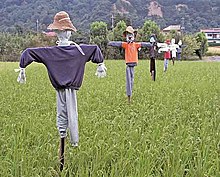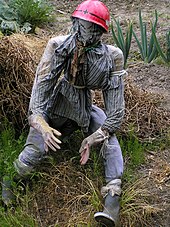Scarecrow

A scarecrow or hay-man is a decoy or mannequin in the shape of a human. It is usually dressed in old clothes and placed in open fields to discourage birds such as crows or sparrows from disturbing and feeding on recently cast seed and growing crops.[1]
Uses
The 1881 Household Cyclopedia of General Information gives the following advice:
Machinery of various kinds, such as wind-mills in miniature, horse rattles, etc., to be put in motion by the wind, are often employed to frighten crows; but with all of these they soon become familiar, when they cease to be of any use whatever.
The most effectual method of banishing them from a field, as far as experience goes, is to combine with one or other of the scarecrows in vogue the frequent use of the musket. Nothing strikes such terror into these sagacious animals as the sight of a fowling-piece and the explosion of gun powder, which they have known so often to be fatal to their race.
Such is their dread of a fowling-piece, that if one is placed upon a dyke or other eminence, it will for a long time prevent them from alighting on the adjacent grounds. Many people now, however, believe that crows like most other birds, do more good by destroying insects and worms, etc., than harm by eating grain.
— Henry Hartshorne, The Household Cyclopedia of General Information[2]
Crows can be a substantial problem for gardens in the springtime: they can work down a row pulling up recently sprouted corn to eat the remaining seed/seedlings. In the southern Appalachians another common method of scaring off crows was use of a dead crow hung upside down from a pole.
Modern scarecrows, though still essentially decoys, seldom take a human shape. On California farmland, highly reflective aluminized PET film ribbons are tied to the plants to create shimmers from the sun. Another approach is automatic noise guns powered by propane gas. One winery in New York uses inflatable tube men or airdancers to scare away birds.[3]



In the United Kingdom, where the use of scarecrows as a protector of crops dates from time immemorial, and where dialects were rife, there are a wide range of alternative names such as:
| Name | Locale |
|---|---|
| Hodmedod | Berkshire |
| Murmet | Devon |
| Hay-man | England |
| Gallybagger | Isle of Wight |
| Tattie Bogal | Isle of Skye |
| Tattie bogle[4]
Bodach-rocais (lit. "old man of the rooks") |
Scotland |
| Mommet | Somerset |
| Mawkin | Sussex |
| Bwbach | Wales |
Cultural impact
The impact of the scarecrow extends beyond its immediate utilitarian function.
In Kojiki, the oldest surviving book in Japan (compiled in the year 712), a scarecrow known as Kuebiko appears as a deity who cannot walk, yet knows everything about the world.
Nathaniel Hawthorne's short story "Feathertop" is about a scarecrow created and brought to life in 17th century Salem, Massachusetts by a witch in league with the devil. The basic framework of the story was used by American dramatist Percy MacKaye in his 1908 play The Scarecrow.
L. Frank Baum's tale The Wonderful Wizard of Oz has a scarecrow as one of the main protagonists. The Scarecrow of Oz was searching for brains from the Great Wizard. The scarecrow was portrayed by Frank Moore in the 1914 film His Majesty, the Scarecrow of Oz, by Ray Bolger in the 1939 film The Wizard of Oz, and by Michael Jackson in the 1978 musical film adaptation The Wiz.
Worzel Gummidge, a scarecrow who came to life in a friendly form, first appeared in series of novels by Barbara Euphan Todd in the 1930s, and later in a popular television adaptation.
The Scarecrow is the alter ego of the Reverend Doctor Christopher Syn, the smuggler hero in a series of novels written by Russell Thorndike. The story was made into the movie Doctor Syn in 1937, and again in 1962 as Captain Clegg. It was taken up by Disney in 1963 and dramatized as a three-part TV miniseries as The Scarecrow of Romney Marsh starring Patrick McGoohan; this was later re-edited and released theatrically as Dr. Syn, Alias the Scarecrow.
A film directed by Jerry Schatzberg in 1973 starring Al Pacino and Gene Hackman is titled Scarecrow and deals with two characters on a journey reminiscent of the one in L. Frank Baum's book.
The Scarecrow is a character in the DC Comics universe, a supervillain and antagonist of Batman; Cillian Murphy portrays the character in Christopher Nolan's Batman trilogy. Similar characters, known as Scarecrow and Straw Man, have appeared in Marvel Comics.
British band Pink Floyd recorded a song called "The Scarecrow" for their debut album, The Piper at the Gates of Dawn. John Cougar Mellencamp's album Scarecrow, which peaked at No. 2 in 1985, spawned five Top 40 singles including "Rain on the Scarecrow" (#21). The song "Scarecrow People" on the XTC album Oranges & Lemons is a cautionary tale about the evolution of mankind to 'scarecrow people' who 'ain't got no brains' and 'ain't got no hearts' and are the result of humans destroying their world with wars and pollution.
Melissa Etheridge recorded the song "Scarecrow" for her 1999 album Breakdown. The song is actually about Matthew Shepard. The title makes reference to the bicyclist who found Shepard tied to a fence, which at first, he thought was a scarecrow.
Tobias Sammet recorded his third Avantasia album with a title The Scarecrow, as a first part of Wicked Trilogy, which tells the story about a Scarecrow.
A scarecrow named Scarecrow is one of the protagonists in Magic Adventures of Mumfie.
Joe's Scarecrow Village in Cape Breton, Canada is a roadside attraction displaying dozens of scarecrows.

The Japanese village of Nagoro, on the island of Shikoku in the Tokushima Prefecture, has 35 inhabitants but more than 350 scarecrows.[5]
Scarecrow festivals


In the UK, the Urchfont Scarecrow Festival [6] was established in the 1990s and has grown into a major local event, attracting up to 10,000 people annually for the May Day Bank Holiday. Originally based on an idea imported from Derbyshire, it was certainly the first to be established in Wiltshire, and was possibly the first in the whole of southern England.
Belbroughton, north Worcestershire, has been holding an annual Scarecrow Weekend on the last weekend of each September since 1996, which raises money for local charities.[7][8] The village of Meerbrook in Staffordshire holds an annual Scarecrow Festival during the month of May. Tetford and Salmonby, Lincolnshire jointly host one.
The festival at Wray, Lancashire was established in the early 1990s and continues to the present day. In the village of Orton, Eden, Cumbria scarecrows are displayed each year, often using topical themes such as a Dalek exterminating a Wind turbine to represent local opposition to a wind farm.
The village of Blackrod, near Bolton in Greater Manchester holds a popular annual Scarecrow Festival over a weekend usually in early July.
Norland, West Yorkshire has a festival. Kettlewell in North Yorkshire has held an annual festival since 1994.[9] In Teesdale, County Durham, the villages of Cotherstone, Staindrop and Middleton-in-Teesdale have annual scarecrow festivals.
Scotland's first scarecrow festival was held in West Kilbride, North Ayrshire in 2004,[10] and there is also one held in Montrose. On the Isle of Skye, the Tattie bogal event,[11] is held each year, scarecrow trail, and other events. Gisburn, Lancashire held its first Scarecrow Festival in June 2014.
In Dymchurch on Romney Marsh a man dressed as a scarecrow has ridden down the street annually since 1964 in celebration of local author Russell Thorndike's Dr Syn books. In 2008 he was required to walk due to health and safety regulations.[citation needed] Tonbridge in Kent also host an annual Scarecrow Trail,[12] organised by the local Rotary Club to raise money for local charities. In the US, St. Charles, Illinois hosts an annual Scarecrow Festival.[13]
The 'pumpkin people' come in the fall months in the valley region of Nova Scotia, Canada. They are scarecrows with pumpkin heads doing various things such as playing the fiddle or riding a wooden horse. Hickling, in the south of Nottinghamshire, is another village that celebrates an annual scarecrow event. It is very popular and has successfully raised a great deal of money for charity.[14] Meaford, Ontario has celebrated the Scarecrow Invasion since 1996.
In the Philippines, the Province of Isabela has recently started a scarecrow festival named after the local language: Bambanti Festival. The Province invites all its Cities and Towns to participate for the festivities, that lasts a week, and has drawn tourists from around the island of Luzon.
The largest gathering of scarecrows in one location is 3,812 and was achieved by National Forest Adventure Farm (UK) in Burton-upon-Trent, Staffordshire, UK, on 7 August 2014.[15]
See also
References
- ^ Lesley Brown (ed.). (2007). "Shorter Oxford English Dictionary on Historical Principles". 6th ed. Oxford: Oxford University Press. ISBN 978-0-19-923324-3.
- ^ Hartshorne, Henry. (1881). "The Household Cyclopedia of General Information". New York: Thomas Kelly.
- ^ New Scarecrows for Vineyards: Car Dealers' Inflatable 'Dancing' Tube Men
- ^ Warrack, Alexander (1982). "Chambers Scots Dictionary". Chambers. ISBN 0-550-11801-2.
- ^ Japanese Village Overrun By Nightmarish Scarecrows, Fangoria, March 2015.
- ^ [1],
- ^ Travis, Jo (2008). "CUTTING-EDGE OF HISTORY; DOWN YOUR WAY Jo Travis reports on a rural idyll that was once a world capital of industry". Birmingham Post & Mail Ltd.
- ^ Scarecrow Committee (a subcommittee of Belbroughton Parochial Church Council). "Belbroughton Scarecrow Festival".
- ^ "Kettlewell Scarecrow Festival draws in crowds". Bbc.co.uk. 2011-08-14. Retrieved 2012-07-12.
- ^ [2] Archived January 14, 2011, at the Wayback Machine
- ^ tattiebogal.co.uk
- ^ "Scarecrow Trail".
- ^ "Scarecrow Festival".
- ^ Published on Tuesday 9 February 2010 14:47 (2010-02-09). "Village hands over £13,500 - Local". Melton Times. Retrieved 2012-07-12.
{{cite web}}: CS1 maint: numeric names: authors list (link) - ^ "Guinness World Records". 7 August 2014.
Further reading
Scarecrow Fact and Fable, Peter Haining, 1986
